Robotics Education Journal
 02/25/2020
02/25/2020 The Defense Advanced Research Projects Agency (DARPA) has announced the Subterranean Challenge ("SubT"). SubT seeks new technologies to help first responders search and map tunnels and caves below the planet’s surface. The global competition asks entrants to develop systems that can help humans navigate, map and search in underground locations that are normally too perilous to visit. Click below for a live feed, details on this exciting competition, and team rankings at the end of yesterday’s 2nd day of competition.
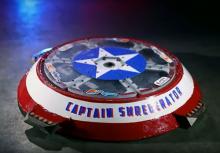 02/23/2020
02/23/2020 A variety of basic designs have emerged in the brutal sport of combat robotics, and these loosely include flippers, hammers, various kinds of bashers, slashers and spinners. Doubtless, the lead spinner designer/combat veteran is event organizer, competitor, and occasional Battlebots and Robot Wars TV host, Brian Nave, CEO of LOGICOM. Brian is the designer and driver of the renowned “Captain Shrederator” spinner combat robot—click below to watch Captain Shrederator in action!
 02/22/2020
02/22/2020 Military[dot]com recently reported that the NAVY’s 2021 budget request includes funds to build a large drone ship that "will ultimately serve as a sensor and shooter." The NAVY’s development of the robotic boat concept appears to be well underway, as the budget request comes on the heels of successful testing of Sea Hunter, a new class of drone ship developed in a partnership between DARPA and the Office of Naval Research (ONR). A related Popular Mechanics story by Kyle Mizokami describes test exercises of the Common Unmanned Surface Vehicle (CUSV – pronounced “Kuss-Vee”), a new robotic boat designed for pier security. CUSV sports a .50 caliber machine gun.
 02/13/2020
02/13/2020 On Thursday, February 6, 2020, Major General Poss (ret), USAF, published an open letter to the FAA on the agency’s proposed remote identification requirement (RID) for unmanned systems, in an article posted by InsideUnmannedSystems[dot]com titled “Draft Remote ID Rules: The Good and The Wait . . . What??”. We recommend reading General Poss’s insightful observations on the draft rules, which could impact in many ways not just drone operators but also thousands of radio control (RC) modelers at RC clubs nationwide. The proposed rules address everything from securing new RC flying fields to ensuring use of rule-compliant RID dongles onboard remotely piloted aircraft to who bears responsibility for avoiding collisions between drones and manned aircraft—and much more.
 02/09/2020
02/09/2020 U.S. Navy unmanned vehicles experts are assembling a 40-member industry team, which is a veritable who's who of prime systems integrators and subsystems designers, to participate in a major effort to design next-generation unmanned surface vessels (USVs). The 40 companies selected to participate in the Unmanned Surface Vehicle Family of Systems project are noted below.
 02/07/2020
02/07/2020 FOR IMMEDIATE RELEASE: IRVINE, CA, February 03, 2020 - Adsys Controls, Inc. has delivered their XSight 1721 next generation video processor to its first customers. The XSight 1721 provides advanced video processing solutions for applications that require reduced Size, Weight, and Power (SWaP). In a form-factor the size of a business card, it provides a multitude of video processing features including target tracking, object detection, object classification, digital stabilization, video encoding, and video translation on up to four simultaneous video streams. The XSight 1721 enables edge computing with significant processing power for various applications including remote sensing, robotic sensing, security surveillance and other scientific applications.
 02/02/2020
02/02/2020 The 25 January 2020 edition of Unmanned Systems News (USN) reports that Israel is developing laser weaponry to interdict drones and rockets. Developments are said to be still very much in the early testing and evaluation stages. In an unrelated news release, PopularMechanics.com reported that U.S. NAVY submarines will be outfitted with laser weapons.
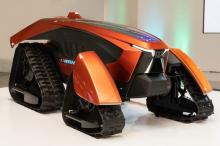 01/31/2020
01/31/2020 On its 130th anniversary, 15 January, 2020, in Kyoto City, Japan, Kubota, a Japanese firm producing tractors and assorted mechanized vehicles announced a new autonomous unmanned ground vehicle (UGV) offering, the “X tractor – cross tractor”. It is an esthetically pleasing design with robust functionality. It is interesting to briefly compare its features with those of the venerable Norway, Maine-based c-Link Systems Forager UGV, which has seen a variety of iterations since the early 2,000’s and, today, serves markets ranging from construction to Search & Rescue.
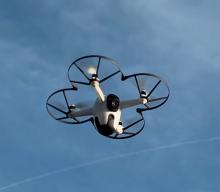 01/26/2020
01/26/2020 Sunflower’s Home Awareness System includes three components: an autonomous drone called the Bee, motion and vibration sensors disguised as garden lights that are to be deployed around one’s home, and a weatherproof charging station called the Hive. If alerted to suspicious activity via a smartphone app, the homeowner can deploy the Bee, which will autonomously check out the activity and live stream its observations. Afterwards, the Bee automatically returns to the Hive, which performs AI-backed data processing and analysis.
 01/24/2020
01/24/2020 CareerCast.com tracks the Top 10 Best Jobs in Engineering on an annual basis in its Job Rated Report, and describes the jobs and prevailing compensation levels. As noted there, "according to the Bureau of Labor Statistics forecasts, virtually all engineering careers have a positive projected growth outlook.” The top locations for both employment and income for some of the best engineering jobs are Texas, California, Oklahoma, Chicago, Dallas-Fort Worth-Arlington metropolitan areas, and Alaska. The three highest average incomes for the engineering profession are in Chicago, Dallas and Anchorage, Alaska.”
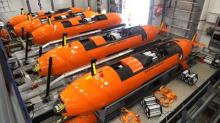 01/18/2020
01/18/2020 In November 2019 a White House summit on Partnerships in Science and Technology announced near-term goals that include a partnership between NOAA and Ocean Infinity to conduct deepwater ocean mapping of the U.S. shoreline and U.S. Exclusive Economic Zone. “This is an exciting step for Ocean Infinity as we combine our leading deepwater exploration technology with NOAA’s prominent authority in ocean science,” Sean Fowler, director of business development for Ocean Infinity, said in a prepared statement. Only 43% of the 3.4 million square nautical miles of coastal and deepwater U.S. territory is currently mapped to modern standards.
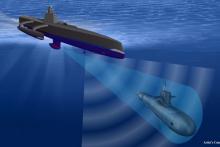 01/14/2020
01/14/2020 The NAVY wants future robotic warships, or unmanned surface vehicles (USVs) to not only abide by the International Regulations for Preventing Collisions at Sea (COLREGS), but also to have the capability to communicate their status in standard English. COLREGS lay down the rules for how 2 ships should navigate when drawing near each other, and computer software onboard USVs is said to currently manage this, but when 3 or more USVs converge, things get more complicated. When 3 or more manned ships converge, bridge crews typically sort out navigation verbally via VHF radio, so the question is how will USVs overcome the current “bottleneck” when one encounters a 3-ship interaction but with no ability to converse?
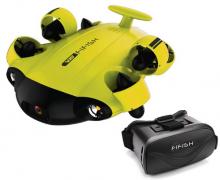 01/11/2020
01/11/2020 AUVSI Miami News reported January 9, 2020 in an update from Finance.yahoo[dot]com, that Asia-based QYSEA exhibited new upgrades to its FIFISH maritime submersible robot at CES 2020 in Las Vegas. Both FIFISH V6+ and FIFISH W6 models were shown. This remarkable omni-directional underwater drone is equipped with 4K UHD video recording and imaging sonar capability. With its 6 thrusters, it has both “active distance lock” to remain a fixed distance from an object it is observing, and can maneuver in 3 dimensions using head tracking control. FIFISH can also freeze its motion in a maneuver called “posture hold”.
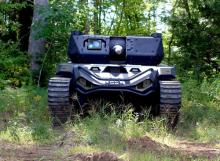 01/10/2020
01/10/2020 The DOD is, by all accounts, moving quickly in the unmanned ground combat systems arena. According to DefenseNews[dot]com, the U.S. Army has picked QinetiQ North America to build 4 “light” robot combat vehicle (RCV) prototypes, and Textron to build 4 “medium” scale RCV prototypes, pending completion of contract negotiations. DefenseNews[dot]com further announced that “Through a rapid contracting mechanism, the National Advanced Mobility Consortium is coordinating the Army’s awards to industry, and the service expects to be officially under contract with both companies by mid-February, according to the statement.”
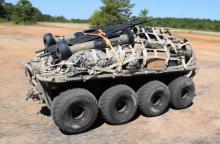 01/05/2020
01/05/2020 In the rapidly advancing era of automated cars, it’s no surprise that there has been a worldwide explosion in semi-autonomous and autonomous Unmanned Ground Vehicles (UGVs). These “robot mules” span military, commercial and research markets. Notably, in late 2019, the U.S. Army selected General Dynamics to produce UGVs under its Small Multipurpose Equipment Transports (SMET) program. Defense Blog reported that an Army contract worth $162.4 million “for up to 624 robotic mules was awarded in October to GDLS, a business unit of General Dynamics. Delivery to Soldiers begins in the second quarter of Fiscal Year 2021.” See SMET details, below, and a photo gallery of a representative sample of commercial, research and military UGVs illustrating the latest generation of robotic mules. This update starts with the pioneering German UGVs of WW2, and the circa-2006 CMU Crusher.
 12/29/2019
12/29/2019 “STEAM” is an expanded version of STEM, and stands for “science, technology, engineering, arts and math”. The "RoboGuts™ S.T.E.A.M. Education Program", which uses the RoboGuts™ circuit board, is an education program that is positioned to be competitive with VEX, LEGO MindStorms, and Arduino STEM learning systems. In its favor, the RoboGuts™ STEAM Education teaches the whole manufacturing process, and includes a beginner’s section using BASIC language to teach structured programming style. The system will be exhibited at the upcoming CES show in Las Vegas.
 12/27/2019
12/27/2019 “Deep learning” is a machine learning method in the field of artificial intelligence (AI) that processes several layers of data in artificial neural networks to deliver an output. MIT has provided a fascinating collection of free courses and lectures on Deep Learning that are hosted by MIT's Lex Fridman, and MIT will be supplementing this library with additional lectures in January 2020.
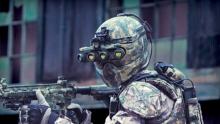 12/22/2019
12/22/2019 The U.S. Army’s Combat Capabilities Development Command, a DOD group, recently released a study noting that eye, ear, muscular and brain enhancement is “technically feasible by 2050 or earlier.” It is expected that the civilian healthcare market will be a strong driver in the development of new cyborg military technologies.
 12/18/2019
12/18/2019 The BBC is getting its toes wet in the virtual news pond, having announced in the last week that it has begun posting automated news updates. In presenting the majority victory by Boris Johnson and the Conservatives, the BBC commented on how computers wrote initial election results, and were uniquely needed. "This is about doing journalism that we cannot do with human beings at the moment," said Robert McKenzie, editor of BBC News Labs. Other leaps forward in automated journalism are taking place in China.
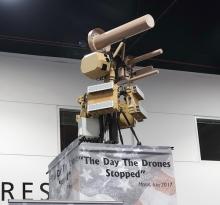 12/09/2019
12/09/2019 On 14 September 2019, relatively inexpensive drones were used to temporarily disable 5% of the world’s oil supply in an attack on the state-owned Saudi Aramco oil processing facilities in eastern Saudi Arabia. A new form of low-cost but technically sophisticated drone warfare was upon us. In a study released today, the National Robotics Education Foundation (NREF) reviews major players developing counter-unmanned aerial systems (C-UAS) weapons. C-UAS systems are being urgently deployed to protect our municipal buildings, stadiums, airports, universities and commercial businesses from drone attacks whether by individual machines or massive drone swarms.
 12/07/2019
12/07/2019 In a significant consolidation of robotics and AI media on December 5th, Robotics Business Review (RBR) and RoboBusiness were acquired by B2B online publisher WTWH Media. RBR is a major online outlet in the robotics and AI arena with a significant readership comprised of industry marketing executives, robotics professionals, educators, researchers, military and law enforcement, and dedicated hobbyists. RoboBusiness is a major annual trade show event that has been held by RBR for many years.
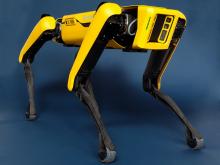 12/06/2019
12/06/2019 Boston Dynamics just announced, yesterday, Spot Release 1.1! This dog-like robot performs data collection, infrastructure monitoring, hazmat inspections and can be used in dangerous missions such as disposal of IEDs. Other applications include security and even package delivery. Boston Dynamics states it is prioritizing business customers, so hobbyists note, Spot is not at this time being marketed to consumers as a robot pet.
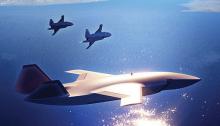 11/30/2019
11/30/2019 Benjamin Minick of the International Business Times (IBT) reported earlier this month that Boeing plans to fly an unmanned fighter jet in 2020 that is piloted by artificial intelligence (AI). His headline included the statement: “Battle For The Skies Set To Change Forever”. Plans are underway to adopt the new platform to fly as a wingman. It, reportedly, also may be used to fly solo in independent missions.
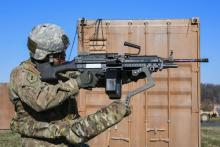 11/28/2019
11/28/2019 The Army Research Laboratory on May 29 published footage of soldiers scrambling through an urban training exercise site at Aberdeen Proving Ground in Maryland with 22-pound M249 and 25-pound M240B machine guns affixed to the end of their harnesses. This was a step up from the 20-lb defensive shield tested last year. One sergeant using the third arm with a carbine "dove into a prone fighting position from a sprint ... [and] the Third Arm provided immediate stabilization to improve marksmanship for the soldier."
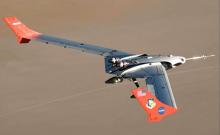 11/23/2019
11/23/2019 This comprehensive Aviation / Aerospace update by MilitaryFactory.com lists 93 UAS designs along with countries of origin. Images of active and conceptual designs in development are shown. Entries are listed by service year, with expandable thumbnails and brief descriptions of different battlefield roles.
